5 Best Tripods for Binoculars in 2024 (Astronomy)
One of the most frustrating things when observing stars or other celestial objects is the moment when your tripod begins to shake, and the image is distorted. Having the right type of tripod can be a life-changer.
I remember how hard it was for me, in the beginning, to find the right type of tripod, staying up late at night and surfing on the web looking for things like “tripod for binoculars astronomy.”
The fact that I even remember this is proof of how frustrating and important it is to choose the right tripod. In this article, through our experience and research, we wish to help you in this endeavor, and hopefully answer all of your questions.
We Recommend
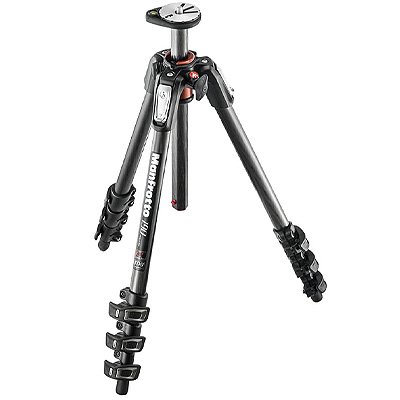
Best carbon fiber
Manfrotto
190xPRO Tripod
Best value/price ratio
Vortex
Pro GT Tripod
Best all-around
Orion
Paragon-Plus XHD
Monopod vs. tripod for astronomy viewing?
Tripods and monopods are among the most used mounts for binoculars or photography in general. They are very different from one another, and the best mount usually depends on your comfortability, but here are some things to consider:
Monopods – Monopods are one-legged tripods. They are usually cheaper and lighter and more portable than tripods. They take the weight of the binoculars off your arms and they make it easier to pivot the binoculars around and look at objects.
Tripods – They are three-legged mounts. They instantly steady the image, and nothing can match them in doing this. This is exactly what you want when you are stargazing. They are usually very durable and some are even compact.
Weight usually means quality when it comes to technology and durability/sturdiness. You have to choose between comfort and quality. Yes, tripods are sometimes heavy and expensive, but they last longer and provide you with real experience.
Monopods, though, cheaper and lighter, are even more uncomfortable. In order to stabilize the image, it all depends on your body, when it comes to tripods, you are more carefree. Monopods are light and thus they can be used-up/break, but you can compromise and buy a lighter tripod.
Related: 5 Best Tripods for Binoculars (Astronomy) in 2020
The length on the astronomy tripod is the secret sauce
When choosing a tripod and head, one must be very careful. When the binocular is pointed at higher altitudes, the height of the eyepieces decreases, and the height of your eyes increases as you tilt your head back. This forces the binoculars to be held over one’s head.
Thus the tripod must be without question adjustable in height in order to observe high altitude objects from a standing position and this can be very challenging since your legs and the tripod’s legs also tend to want to occupy the same space.
The human head can tilt back comfortably at around 45 to 60 degrees from a straight forward position. As such, you should aim to choose a tripod which should be around 6 inches taller than you are when it is fully extended in order to stay relaxed.
If the tripod is less than 6 inches taller than you, then it can get quite frustrating. You won’t be able to relax and observe what you want, and since you aren’t focusing on standing still, the tripod is susceptible to vibration if it isn’t sturdy enough, and thus the image is destabilized.
The weight of the tripod is the key
After the length, the most important thing to consider is the weight of the tripod, especially in correspondence with the weight of the binoculars. Generally, the tripod should have at least twice the weight of the binoculars. Weight can also mean sturdiness and durability.
The heavier the binoculars are, the more unstable the tripod may become with the weight-off center. The material is also important. Wood type tripods are heavy, but they play a great role in absorbing vibrations, they may be the best at doing this, though too heavy can also be bad.
Carbon fiber tripods are lighter and offer stability, but they are more expensive. In regards to aluminum, it is affordable, usually light, but sadly, it’s very prone to channeling vibrations. Sometimes, hanging something under the column can help shift the center of mass.
So, for example, if you have Celestron Skymaster 20×80 binoculars – 4.8 lbs, and a Vanguard 263AT tripod with an SBH-100 head which has a loading capacity of 22 lbs, and the legs tilted loading capacity of 11 lbs, it should work decently. Often times the legs can be upgraded if need be.
You will need a tripod adaptor
Some binoculars don’t’ have built-in tripod mounts; as such, they are listed as tripod adaptable or as having a tripod socket. Adaptors are sold separately. The tripod socket is located under a cap on the front of the center hinge that holds up the halves of the binocular. The cap unthreads itself and reveals the tripod socket underneath.
If this is not the case, then your binocular is not threaded for a tripod adapter. You have to thread the top of the tripod adapter into this socket, and then thread the other end of the adapter onto the stud of any camera or photo tripod. Some of the best tripod adapters and mounts are the tripod L adapters and the parallelogram mount.
L adapters usually allow more freedom of movement and tilting from side to side. The best L adapters are Orion’s deluxe, a simple tall L bracket, and UA deluxe. L adapters can help eliminate shake, are sturdy, and come in all variations, just about perfect for anyone.
Parallelogram mounts are great for binoculars of around 8 pounds. They give a wide range of viewing, even for people of different heights or seated viewing. The side-arm parallelogram is great to use in sitting positions, and it is probably the most versatile.
How to choose the right tripod for astronomy binoculars?
Choosing the right tripod for your binoculars involves careful consideration and patience. You clearly have to take into consideration what you want to view, how often, and where do you use it/take it with you. As such, here are 5 things to consider before choosing an astronomy binocular tripod:
Height – The tripod needs to be adjustable in height and it should be around 6 inches taller than the user when it is fully extended.
Weight – The tripod should be around two times heavier than the binoculars in order to have a good enough balance.
Material – Wood is great for vibration absorption, carbon fiber is light and offers stability while aluminum is the cheapest/lightest but prone to vibrations.
Adaptor compatibility – In most cases, you don’t have to match the tripod adapter to your binocular. The thread size on the binocular socket is standardized at 1/4×20.
Stability – This is the most important aspect. Optics that have extreme zoom capabilities are prone to have the image destabilized by even the most minor movements.
To reach the perfect stability, you have to consider all the other four previously described tips. This should be a pleasant experience, so take your height into consideration and the tripod’s height. Make sure it is 6 inches taller than you, adjustable, has double the weight of the binoculars, and adaptor compatibility.
Best tripod for binoculars (astronomy)
1. Orion Tritech II Field Tripod
This Orion tripod comes with an included zippered carry case. It is portable and sturdy enough for loads of up to 13.2 lbs.
The tripod legs are 3-section extendable and they are made out of aluminum alloy.
Though aluminum is susceptible to vibrations, this product also has a metal spreader brace, which may add more stability.
It has an extra-long slotted 1/4″-20 captive quick-release shoe which allows for a very secure attachment for cameras, spotting scopes, and L-adapter equipped binoculars with a non-slip grip.
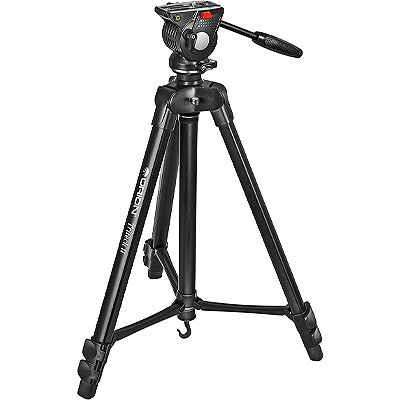
It is lightweight and has an integrated ballast hook. It is located in the tripods center column at the bottom.
This hook allows for counterweights to be put in place and enhance stability, and prevent wind-induced vibrations. This tripod can support cameras and binoculars, but it may not be good for telescopes.
Check the price of Orion Tritech II Field Tripod here
Matching binocular mount: Snapzoom Universal Mount
What we liked
- Up to 13.2 lbs load support
- Height adjustable
- Secure attachment model
- Non-slip grip
- Easy portability/lightweight
- Fairly priced
- Hook for the counterweight
What we didn’t like
- Material might be vibration susceptible
- Might not be sturdy enough
Material: Aluminum alloy
Max. Height: 68.2 inches
Weight: 4.8 pounds
Weight capacity: Up to 13.2-lbs binos
2. Bushnell 784030 Advanced Tripod
This might be a good option for stargazing amateurs, but the lack of quick release head and legs may prove frustrating to some, it all depends on your needs. It might be a good tripod for watching wildlife as well.
The product is durable and supports weights of up to 11lb, and the pan head is easy to adjust without much wobble.
The center column nut does its job as it holds the column tightly.
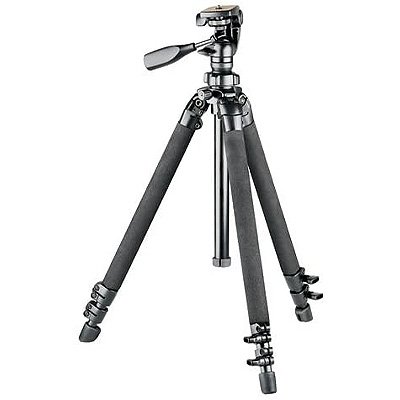
The legs are paddled and offer comfort and protection in extremely cold or hot conditions. These paddled legs also provide a solid grip.
The pan head includes a standard 1/4″-20 screw mount and not a quick-release mount, as stated in the manual. It is reasonably light and since the legs are individually adjustable, you might find the perfect height for your viewing.
Check the price of Bushnell 784030 Advanced Tripod here
Matching binocular mount: Bushnell Tripod Adapter
What we liked
- Height adjustability
- 3-way pan/tilt head
- Universal 1/4″-20 mount
- Hot/cold environment resistant
- Slicing center column with tension control
- Durable / sturdy
- Lightweight / portability
What we didn’t like
- No quick release head
- Single-center column
- No storage/package included
Material: Aluminum
Max. Height: 63 inches
Weight: 5.5 pounds
Weight capacity: Up to 11-pound binos
3. Orion Paragon-Plus XHD Extra Heavy-Duty Tripod
This Orion Paragon tripod may support both big and small binoculars and cameras, but it may not be the best choice for heavy equipment.
The tilt and pan head may need to be replaced to handle greater weights.
It is a good choice for stargazers, photographers, and the product comes with a 1/4-20 quick-release shoe, cushion/spike feet, and bubble level.
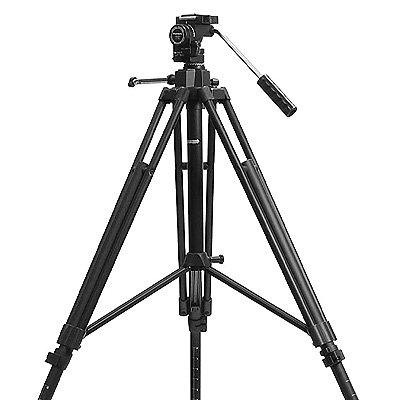
The legs are tri-braced to the center elevator for enhanced stability and they have each inch marked for easy adjustment of height and position.
The included round bubble level at the top of the tripod, which comes in very handy, is also retractable and exposes metal pegs that help keep the tripod firm in soil.
It is a solid tripod that resists both shaking from ground vibrations, and wind gusts.
Check the price of Orion Paragon-Plus XHD Extra Heavy-Duty Tripod here
Matching binocular mount: Orion 5376 Paragon-Plus
What we liked
- Adjustable height
- Two-way fluid pan head
- Tension adjustment / controlled motion
- Easy to set-up
- Very durable
- Resistant to shaking/vibrations
- Fairly light/portability
What we didn’t like
- Might not be good for heavier equipment
- May be too heavy for some
Material: Aluminum
Max. Height: 68 inches
Weight: 9 pounds
Weight capacity: Up to around 17-pound binos
4. Vortex Optics Pro GT Tripod
Though it is light, this Vortex Optics tripod is very sturdy and can support greater weights.
The product comes with an included carry case, 3-way pan head, and quick-release plate.
It might be a good option for both stargazers and photographers. The lever is made out of plastic and, as such, might not be durable.
The tripod legs are anodized and sturdy. Combined with a rugged 3-way quick-release pan/tilt head, it delivers smooth and solid support for most optics.
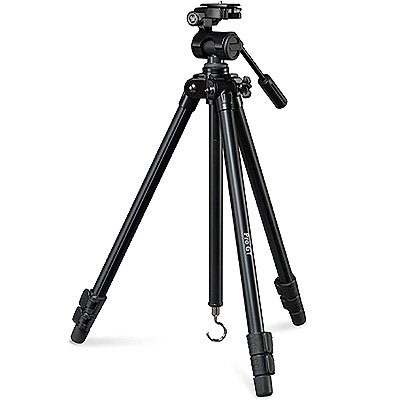
The flip lever leg locks are valued for rapid set up and height adjustment. The rubber feet provide a more solid footing on slick surfaces. The balance hook holds extra weight on the bottom of the center column.
Thus, with counterweights, stability is greatly increased even in windy conditions. The center pole breaks into a couple of sections and thus makes the tripod easier to use at the shortest height. Its lightness makes it very portable.
Check the price of Vortex Optics Pro GT Tripod here
Matching binocular mount: Orion 5376 Paragon-Plus
What we liked
- Height adjustability
- Very light/portability
- Carry case included
- 3-way pan head included
- Very sturdy and reliable
- Flip lever leg locks
- Easy to use at different heights
What we didn’t like
- Plastic lever
- Head might not be suitable for some
Material: Anodized aluminum / plastic lever
Max. Height: 67.1 inches
Weight: 1.44 ounces
Weight capacity: Around 10-pound binos
5. Manfrotto 190XPRO Carbon Fiber 4-Section Tripod
This Manfrotto tripod might be suited for both professional and amateur stargazers and photographers. The quick power lock lever design allows you to easily deploy and adjust the tripod.
All locks on each leg can be released with one hand and a single movement. The legs are 100% made of carbon fiber, which is light but great for stability.
Its compactness allows for easier portability and the column is accessible with a quick “one finger” operation.

The easy link plug enables a fairly instant connection between the tripod and other accessories. The center column extends in height and can be flipped horizontally, great for photography.
The tripod is light, portable, and fairly durable. It is described as being resistant at temperatures of 60 C and minus 30 C.
Check the price of Manfrotto 190XPRO Carbon Fiber 4-Section Tripod here
Matching binocular mount: Manfrotto XPRO Magnesium
What we liked
- Height adjustability
- Link plug for instant accessory connections
- Built-in rotating bubble level
- Q90 Column for great positioning possibilities
- Maximum Working Temperature 60 C
- Minimum Working Temperature minus 30 C
- Fairly light and durable
What we didn’t like
- Plastic lever
- Might be a bit pricey
Material: Carbon fiber
Max. Height: 63 inches
Weight: 3.6 pounds
Weight capacity: Up to 15.4 pound binos
Also read:

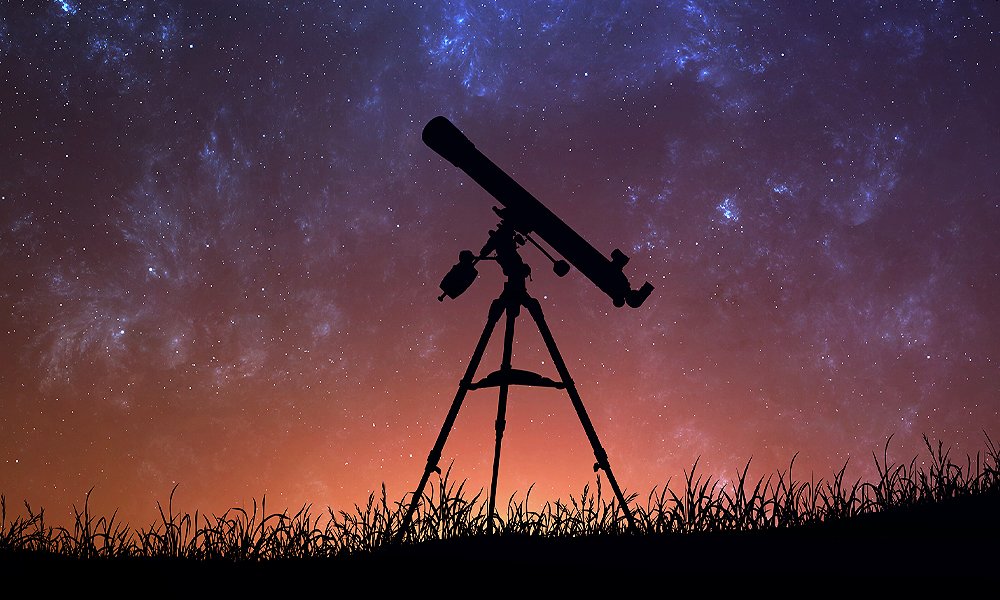
![5 Best Telescope Eyepieces in 2024 [+Beginner’s Guide]](https://www.planetguide.net/wp-content/uploads/2019/12/telescope-eyepieces-768x461.jpg)
![5 Best Star Projectors in 2024 [for Home Planetarium]](https://www.planetguide.net/wp-content/uploads/2019/12/graham-holtshausen-fUnfEz3VLv4-unsplash-768x513.jpg)
![5 Best Astronomy Observing Chairs in 2024 [Ergonomic & Comfortable]](https://www.planetguide.net/wp-content/uploads/2019/12/astronomy-chair-768x461.jpg)